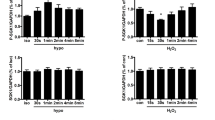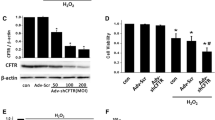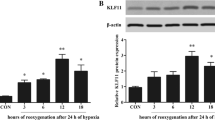Abstract
Bestrophin 3 (Best-3) is expressed in a variety of tissues, such as cardiac, smooth muscle and renal tissues, and it is highly expressed in rat basilar arterial smooth muscle cells (BASMCs). Lee et al. (Biochim Biophys Acta 1823:1864–1876, 2012) reported that Best-3 prevented apoptotic cell death induced by endoplasmic reticulum stress. In the present study, we used small interference RNA (siRNA) and bestrophin 3 cDNA transfection strategy to investigate whether Best-3 can provide a protective effect on apoptosis induced by hydrogen peroxide (H2O2) in BASMCs and studied the underlying mechanisms. We found that silencing of Best-3 with siRNA resulted in an increased H2O2-induced apoptosis and a decreased cell viability, whereas overexpression of Best-3 significantly prevented the apoptotic cell death and increased the cell viability. Overexpression of Best-3 could stabilize the mitochondrial membrane potential, increase the ratio of Bcl-2/Bax, and decrease cytochrome c release and caspase-3 activation. In contrast, silencing of Best-3 produced the opposite effects. Our present data strongly suggest that Best-3 inhibits apoptosis induced by H2O2 in BASMCs through mitochondria dependent pathway.






Similar content being viewed by others
References
Petrukhin K, Koisti MJ, Bakall B et al (1998) Identification of the gene responsible for Best macular dystrophy. Nat Genet 19:241–247
Marquardt A, Stohr H, Passmore LA, Kramer F, Rivera A, Weber BH (1998) Mutations in a novel gene, VMD2, encoding a protein of unknown properties cause juvenile-onset vitelliform macular dystrophy (Best’s disease). Hum Mol Genet 7:1517–1525
Tsunenari T, Sun H, Williams J et al (2003) Structure-function analysis of the bestrophin family of anion channels. J Biol Chem 278:41114–41125
Marmorstein AD, Marmorstein LY, Rayborn M, Wang X, Hollyfield JG, Petrukhin K (2000) Bestrophin, the product of the Best vitelliform macular dystrophy gene (VMD2), localizes to the basolateral plasma membrane of the retinal pigment epithelium. Proc Natl Acad Sci USA 97:12758–12763
Caldwell GM, Kakuk LE, Griesinger IB et al (1999) Bestrophin gene mutations in patients with Best vitelliform macular dystrophy. Genomics 58:98–101
Zhang Y, Patil RV, Marmorstein AD (2010) Bestrophin 2 is expressed in human non-pigmented ciliary epithelium but not retinal pigment epithelium. Mol Vis 16:200–206
Bakall B, McLaughlin P, Stanton JB et al (2008) Bestrophin-2 is involved in the generation of intraocular pressure. Invest Ophthalmol Vis Sci 49:1563–1570
O’Driscoll KE, Hatton WJ, Burkin HR, Leblanc N, Britton FC (2008) Expression, localization, and functional properties of Bestrophin 3 channel isolated from mouse heart. Am J Physiol Cell Physiol 295:C1610–C1624
Matchkov VV, Larsen P, Bouzinova EV et al (2008) Bestrophin-3 (vitelliform macular dystrophy two-like three protein) is essential for the cGMP-dependent calcium-activated chloride conductance in vascular smooth muscle cells. Circ Res 103:864–872
Lee WK, Chakraborty PK, Roussa E, Wolff NA, Thevenod F (2012) ERK1/2-dependent bestrophin-3 expression prevents ER-stress-induced cell death in renal epithelial cells by reducing CHOP. Biochim Biophys Acta 1823:1864–1876
Wang M, Yang H, Zheng LY et al (2012) Downregulation of TMEM16A calcium-activated chloride channel contributes to cerebrovascular remodeling during hypertension by promoting basilar smooth muscle cell proliferation. Circulation 125:697–707
Barro SR, Spitzner M, Schreiber R, Kunzelmann K (2009) Bestrophin-1 enables Ca2+-activated Cl− conductance in epithelia. J Biol Chem 284:29405–29412
Barro-Soria R, Schreiber R, Kunzelmann K (2008) Bestrophin 1 and 2 are components of the Ca(2+) activated Cl(−) conductance in mouse airways. Biochim Biophys Acta 1783:1993–2000
Park H, Oh SJ, Han KS et al (2009) Bestrophin-1 encodes for the Ca2+-activated anion channel in hippocampal astrocytes. J Neurosci 29:13063–13073
Shi XL, Wang GL, Zhang Z et al (2007) Alteration of volume-regulated chloride movement in rat cerebrovascular smooth muscle cells during hypertension. Hypertension 49:1371–1377
Facchiano F, D’Arcangelo D, Riccomi A, Lentini A, Beninati S, Capogrossi MC (2001) Transglutaminase activity is involved in polyamine-induced programmed cell death. Exp Cell Res 271:118–129
Tang YB, Liu YJ, Zhou JG, Wang GL, Qiu QY, Guan YY (2008) Silence of ClC-3 chloride channel inhibits cell proliferation and the cell cycle via G/S phase arrest in rat basilar arterial smooth muscle cells. Cell Prolif 41:775–785
Qian Y, Du YH, Tang YB et al (2011) ClC-3 chloride channel prevents apoptosis induced by hydrogen peroxide in basilar artery smooth muscle cells through mitochondria dependent pathway. Apoptosis 16:468–477
Kunzelmann K, Kongsuphol P, Aldehni F et al (2009) Bestrophin and TMEM16-Ca(2+) activated Cl(−) channels with different functions. Cell Calcium 46:233–241
Marmorstein LY, Wu J, McLaughlin P et al (2006) The light peak of the electroretinogram is dependent on voltage-gated calcium channels and antagonized by bestrophin (best-1). J Gen Physiol 127:577–589
Marmorstein AD, Kinnick TR (2007) Focus on molecules: bestrophin (best-1). Exp Eye Res 85:423–424
Hartzell HC (2008) Physiology. CaCl-ing channels get the last laugh. Science 322:534–535
Marmorstein AD, Cross HE, Peachey NS (2009) Functional roles of bestrophins in ocular epithelia. Prog Retin Eye Res 28:206–226
Spitzner M, Martins JR, Soria RB et al (2008) Eag1 and Bestrophin 1 are up-regulated in fast-growing colonic cancer cells. J Biol Chem 283:7421–7428
Aldehni F, Spitzner M, Martins JR, Barro-Soria R, Schreiber R, Kunzelmann K (2009) Bestrophin 1 promotes epithelial-to-mesenchymal transition of renal collecting duct cells. J Am Soc Nephrol 20:1556–1564
Broegger T, Jacobsen JC, Secher DV et al (2011) Bestrophin is important for the rhythmic but not the tonic contraction in rat mesenteric small arteries. Cardiovasc Res 91:685–693
Reichhart N, Milenkovic VM, Halsband CA, Cordeiro S, Strauss O (2010) Effect of bestrophin-1 on L-type Ca2+ channel activity depends on the Ca2+ channel beta-subunit. Exp Eye Res 91:630–639
Milenkovic VM, Krejcova S, Reichhart N, Wagner A, Strauss O (2011) Interaction of bestrophin-1 and Ca2+ channel beta-subunits: identification of new binding domains on the bestrophin-1 C-terminus. PLoS One 6:e19364
Green DR, Reed JC (1998) Mitochondria and apoptosis. Science 281:1309–1312
Petronilli V, Penzo D, Scorrano L, Bernardi P, Di Lisa F (2001) The mitochondrial permeability transition, release of cytochrome c and cell death. Correlation with the duration of pore openings in situ. J Biol Chem 276:12030–12034
Li SY, Wang XG, Ma MM et al (2012) Ginsenoside-Rd potentiates apoptosis induced by hydrogen peroxide in basilar artery smooth muscle cells through the mitochondrial pathway. Apoptosis 17:113–120
Acknowledgments
This study was supported by National Basic Research Program of China (973 Project No. 2009CB521903) and National Natural Science Foundation of China (Key Grants No. 81230082, 81173055 and 81273500).
Author information
Authors and Affiliations
Corresponding author
Additional information
Lei Jiang, Yun Liu, and Ming-Ming Ma contributed equally to this study.
Rights and permissions
About this article
Cite this article
Jiang, L., Liu, Y., Ma, MM. et al. Mitochondria dependent pathway is involved in the protective effect of bestrophin-3 on hydrogen peroxide-induced apoptosis in basilar artery smooth muscle cells. Apoptosis 18, 556–565 (2013). https://doi.org/10.1007/s10495-013-0828-4
Published:
Issue Date:
DOI: https://doi.org/10.1007/s10495-013-0828-4




